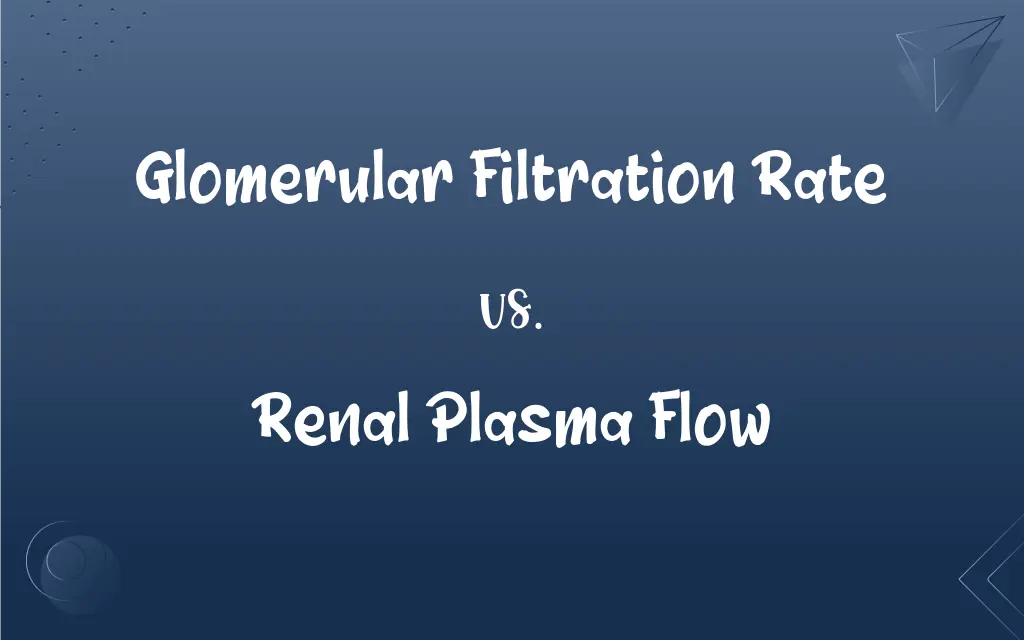Glomerular Filtration Rate vs. Renal Plasma Flow: What's the Difference?
Edited by Aimie Carlson || By Harlon Moss || Updated on October 29, 2023
Glomerular filtration rate (GFR) measures kidney function by the volume of filtered fluid per time, while renal plasma flow (RPF) is the volume of plasma passing through kidneys per time

Key Differences
The glomerular filtration rate (GFR) refers to the volume of plasma filtered through the glomeruli of the kidneys per minute. On the other hand, renal plasma flow (RPF) is the volume of plasma that reaches the kidneys per minute. Both these parameters give valuable insights into kidney function, but while GFR measures the efficiency of filtration, RPF provides information on the blood supply to the kidneys.
In understanding kidney function, glomerular filtration rate serves as an important index of how effectively the kidneys are filtering waste products from the blood. Renal plasma flow, conversely, indicates the total blood flow to the kidneys, but not all of this blood undergoes filtration. Both GFR and RPF play pivotal roles in maintaining homeostasis within the body.
One can envision the glomerular filtration rate as a subset of the renal plasma flow. While the GFR represents the portion of the RPF that gets filtered in the glomeruli, RPF represents the total volume of plasma passing through the renal vasculature. It's essential to recognize that while all of the GFR is subjected to filtration, only a fraction of the RPF undergoes this process.
When assessing kidney health, both glomerular filtration rate and renal plasma flow provide different perspectives. A reduced GFR might indicate issues with the filtering capacity of the kidneys, such as in chronic kidney disease. In contrast, a reduced RPF might hint at compromised blood flow to the kidneys, potentially due to vascular issues. Thus, understanding both GFR and RPF can give a comprehensive view of renal function.
The balance between glomerular filtration rate and renal plasma flow is tightly regulated by various physiological mechanisms. GFR can be influenced by factors like blood pressure and the state of the glomerular capillaries. Meanwhile, RPF can be affected by overall renal blood flow and vascular resistance. Both GFR and RPF, in tandem, ensure that the kidneys perform their filtration and regulatory roles efficiently.
ADVERTISEMENT
Comparison Chart
Definition
Volume of filtered fluid per unit time
Volume of plasma passing through per unit time
Significance
Reflects kidney filtering capacity
Indicates renal blood flow and perfusion
Measurement
Using filtration markers like creatinine
Assessed through clearance tests
Clinical Relevance
Critical for assessing kidney function
Provides insight into kidney perfusion
Indication of Changes
Decrease signals reduced kidney function
Alterations can indicate changes in perfusion
ADVERTISEMENT
Glomerular Filtration Rate and Renal Plasma Flow Definitions
Glomerular Filtration Rate
Assessed using markers like creatinine.
His GFR was calculated using serum creatinine levels.
Renal Plasma Flow
Reflects kidney perfusion.
Decreased renal plasma flow may indicate poor perfusion.
Glomerular Filtration Rate
Measured in milliliters per minute.
Her GFR of 90 mL/min reflects healthy kidney function.
Renal Plasma Flow
Measured in liters per minute.
Her renal plasma flow was 1.2 liters/min.
Glomerular Filtration Rate
Indicates kidney's filtering capacity.
High GFR suggests efficient kidney filtration.
Renal Plasma Flow
Plasma volume passing through kidneys per time.
Renal plasma flow is crucial for filtering blood.
Glomerular Filtration Rate
Rate at which kidneys filter blood.
A low GFR may indicate kidney dysfunction.
Renal Plasma Flow
Assessed via clearance tests.
Renal plasma flow was measured using para-aminohippurate.
Glomerular Filtration Rate
Vital parameter in nephrology.
Monitoring GFR is essential in kidney disease management.
Renal Plasma Flow
Important in renal physiology.
Understanding renal plasma flow aids in diagnosing kidney issues.
FAQs
How is GFR measured?
It's measured using markers like creatinine or inulin.
How is renal plasma flow assessed?
It's often assessed through clearance tests using substances like para-aminohippurate.
Is GFR important for diagnosing kidney issues?
Yes, it's crucial for assessing and diagnosing kidney problems.
What factors can influence GFR?
Age, gender, muscle mass, and kidney health can influence GFR.
Is GFR used in kidney transplant evaluations?
Yes, it's a critical parameter in assessing donor and recipient kidney function.
What is glomerular filtration rate?
GFR is the rate at which kidneys filter blood.
Can GFR be improved with treatment?
In some cases, appropriate treatment can help improve or stabilize GFR.
Is renal plasma flow a static parameter?
No, it can change based on physiological conditions and health status.
What does a high renal plasma flow indicate?
It may indicate increased renal perfusion or hyperfiltration.
What does renal plasma flow indicate?
It indicates the volume of plasma passing through the kidneys.
What can affect renal plasma flow?
Factors like blood pressure and renal artery stenosis can affect it.
Can renal plasma flow provide insights into kidney perfusion?
Yes, it's indicative of renal blood flow and perfusion.
Does hydration status affect renal plasma flow?
Yes, hydration can impact renal blood flow and plasma volume.
How often should GFR be monitored in kidney patients?
Regular monitoring is essential, often based on the severity of the disease.
What's a normal range for GFR?
A normal GFR is typically above 90 mL/min/1.73m².
Does age affect renal plasma flow?
Renal plasma flow may decrease with aging.
Can GFR change with kidney disease?
Yes, it typically decreases with kidney dysfunction.
Can medications affect GFR?
Yes, some medications can impact kidney filtration rates.
Can renal plasma flow help in diagnosing renal artery stenosis?
Yes, changes in flow can indicate conditions like renal artery stenosis.
What does a decrease in GFR signify?
A decrease often signals reduced kidney function.
About Author
Written by
Harlon MossHarlon is a seasoned quality moderator and accomplished content writer for Difference Wiki. An alumnus of the prestigious University of California, he earned his degree in Computer Science. Leveraging his academic background, Harlon brings a meticulous and informed perspective to his work, ensuring content accuracy and excellence.
Edited by
Aimie CarlsonAimie Carlson, holding a master's degree in English literature, is a fervent English language enthusiast. She lends her writing talents to Difference Wiki, a prominent website that specializes in comparisons, offering readers insightful analyses that both captivate and inform.































































